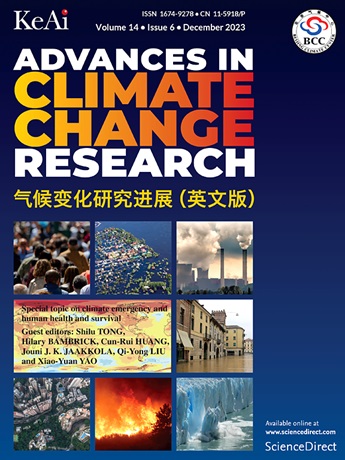Impact of ambient temperatures on Alzheimer's disease and other dementia mortality among elderly patients aged 60 years and older in China
IF 6.4
1区 地球科学
Q1 ENVIRONMENTAL SCIENCES
引用次数: 0
Abstract
China has a large number of patients with Alzheimer's disease (AD) and types of other dementia, which places a heavy burden on the public health and medical systems. As global climate change results in more frequent extreme weather events, and there is a current lack of understanding regarding the impact of non-optimal temperatures, especially cold, on AD and other dementia mortality, the study aimed to identify patterns of temperature sensitivity in order to inform targeted public health strategies. The records of 399,214 decedents aged 60 years and older who died due to AD or other dementias from 2013 to 2020 were obtained from the China Cause of Death Reporting System. Using an individual-level time-stratified case-crossover study design, the relationships between ambient temperatures and AD and other dementia mortality were quantified using conditional logistic regression combined with the distributed lag nonlinear model. In addition, the attributable fractions (AFs) of mortality due to non-optimal ambient temperatures were calculated. The study found that both low and high non-optimal temperatures were associated with an increased risk of death from AD and other dementias, with an inverted J-shaped exposure–response curve. Moreover, the AFs of mortality due to full, low and high non-optimal temperatures with lag0–14 were 5.81% (95% empirical confidence interval [eCI]: 4.89%, 6.72%), 5.24% (95% eCI: 4.15%, 6.27%) and 0.58% (95% eCI: 0.27%, 0.90%), respectively. Importantly, AFs varied across administrative regions, influenced by factors such as climate, geography, sociodemographic characteristics and socioeconomic factors. These findings can inform clinical and public health practices to reduce the mortality burden due to non-optimal temperatures on elderly populations with AD and other dementias.
环境温度对中国60岁及以上老年患者阿尔茨海默病和其他痴呆症死亡率的影响
中国有大量阿尔茨海默病(AD)和其他类型的痴呆症患者,这给公共卫生和医疗系统带来了沉重的负担。由于全球气候变化导致极端天气事件更加频繁,并且目前缺乏对非最佳温度(特别是寒冷)对阿尔茨海默病和其他痴呆症死亡率的影响的了解,该研究旨在确定温度敏感性模式,以便为有针对性的公共卫生战略提供信息。从中国死亡原因报告系统中获取2013 - 2020年因阿尔茨海默病或其他痴呆症死亡的60岁及以上的399214名死者的记录。采用个体水平时间分层病例交叉研究设计,使用条件logistic回归结合分布滞后非线性模型量化环境温度与AD和其他痴呆死亡率之间的关系。此外,计算了非最佳环境温度导致的死亡率归因分数(AFs)。研究发现,低和高的非最佳温度都与阿尔茨海默病和其他痴呆症的死亡风险增加有关,呈倒j型暴露-反应曲线。在lag0 ~ 14时,全、低、高非最适温度死亡率AFs分别为5.81%(95%经验置信区间[eCI]: 4.89%、6.72%)、5.24% (95% eCI: 4.15%、6.27%)和0.58% (95% eCI: 0.27%、0.90%)。重要的是,受气候、地理、社会人口特征和社会经济因素等因素的影响,AFs在行政区域之间存在差异。这些发现可以为临床和公共卫生实践提供信息,以减少老年阿尔茨海默病和其他痴呆症患者因非最佳温度造成的死亡率负担。
本文章由计算机程序翻译,如有差异,请以英文原文为准。
求助全文
约1分钟内获得全文
求助全文
来源期刊

Advances in Climate Change Research
Earth and Planetary Sciences-Atmospheric Science
CiteScore
9.80
自引率
4.10%
发文量
424
审稿时长
107 days
期刊介绍:
Advances in Climate Change Research publishes scientific research and analyses on climate change and the interactions of climate change with society. This journal encompasses basic science and economic, social, and policy research, including studies on mitigation and adaptation to climate change.
Advances in Climate Change Research attempts to promote research in climate change and provide an impetus for the application of research achievements in numerous aspects, such as socioeconomic sustainable development, responses to the adaptation and mitigation of climate change, diplomatic negotiations of climate and environment policies, and the protection and exploitation of natural resources.
 求助内容:
求助内容: 应助结果提醒方式:
应助结果提醒方式:


